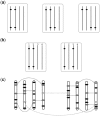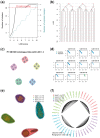polymapR-linkage analysis and genetic map construction from F1 populations of outcrossing polyploids
- PMID: 29722786
- PMCID: PMC6184683
- DOI: 10.1093/bioinformatics/bty371
polymapR-linkage analysis and genetic map construction from F1 populations of outcrossing polyploids
Erratum in
-
polymapR-linkage analysis and genetic map construction from F1 populations of outcrossing polyploids.Bioinformatics. 2019 Feb 1;35(3):540. doi: 10.1093/bioinformatics/bty1002. Bioinformatics. 2019. PMID: 30629112 Free PMC article. No abstract available.
Abstract
Motivation: Polyploid species carry more than two copies of each chromosome, a condition found in many of the world's most important crops. Genetic mapping in polyploids is more complex than in diploid species, resulting in a lack of available software tools. These are needed if we are to realize all the opportunities offered by modern genotyping platforms for genetic research and breeding in polyploid crops.
Results: polymapR is an R package for genetic linkage analysis and integrated genetic map construction from bi-parental populations of outcrossing autopolyploids. It can currently analyse triploid, tetraploid and hexaploid marker datasets and is applicable to various crops including potato, leek, alfalfa, blueberry, chrysanthemum, sweet potato or kiwifruit. It can detect, estimate and correct for preferential chromosome pairing, and has been tested on high-density marker datasets from potato, rose and chrysanthemum, generating high-density integrated linkage maps in all of these crops.
Availability and implementation: polymapR is freely available under the general public license from the Comprehensive R Archive Network (CRAN) at http://cran.r-project.org/package=polymapR.
Supplementary information: Supplementary data are available at Bioinformatics online.
Figures



References
-
- Acquaah G. (2012). Principles of Plant Genetics and Breeding. Wiley-Blackwell; , West Sussex, UK.
-
- Bourke P.M. et al. (2017) Partial preferential chromosome pairing is genotype dependent in tetraploid rose. Plant J., 90, 330–343. - PubMed
Publication types
MeSH terms
LinkOut - more resources
Full Text Sources
Other Literature Sources

